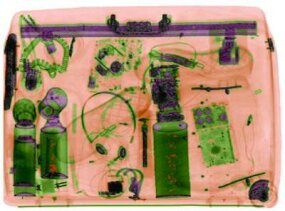X-Ray Scanners
X-Ray Scanners
While you are stepping through the metal detector, your carry-on items are going through the X-ray system. A conveyor belt carries each item past an X-ray machine. X-rays are like light in that they are electromagnetic waves, but they are more energetic, so they can penetrate many materials. The machine used in airports usually is based on a dual-energy X-ray system. This system has a single X-ray source sending out X-rays, typically in the range of 140 to 160 kilovolt peak (KVP). KVP refers to the amount of penetration an X-ray makes. The higher the KVP, the further the X-ray penetrates.
After the X-rays pass through the item, they are picked up by a detector. This detector then passes the X-rays on to a filter, which blocks out the lower-energy X-rays. The remaining high-energy X-rays hit a second detector. A computer circuit compares the pick-ups of the two detectors to better represent low-energy objects, such as most organic materials.
Since different materials absorb X-rays at different levels, the image on the monitor lets the machine operator see distinct items inside your bag. Items are typically colored on the display monitor, based on the range of energy that passes through the object, to represent one of three main categories:
- Organic
- Inorganic
- Metal

While the colors used to signify “inorganic” and “metal” may vary between manufacturers, all X-ray systems use shades of orange to represent “organic.” This is because most explosives are organic. Machine operators are trained to look for suspicious items — and not just obviously suspicious items like guns or knives, but also anything that could be a component of an improvised explosive device (IED). Since there is no such thing as a commercially available bomb, IEDs are the way most terrorists and hijackers gain control. An IED can be made in an astounding variety of ways, from basic pipe bombs to sophisticated, electronically-controlled component bombs.
A common misconception is that the X-ray machine used to check carry-on items will damage film and electronic media. In actuality, all modern carry-on X-ray systems are considered film-safe. This means that the amount of X-ray radiation is not high enough to damage photographic film. Since electronic media can withstand much more radiation than film can, it is also safe from damage. However, the CT scanner and many of the high-energy X-ray systems used to examine checked baggage can damage film (electronic media is still safe), so you should always carry film with you on the plane.

